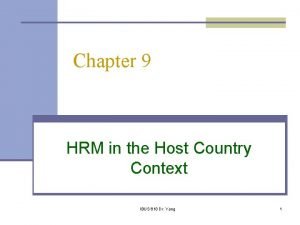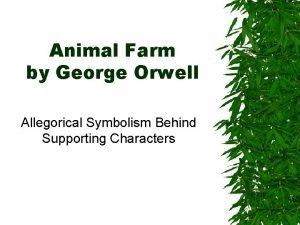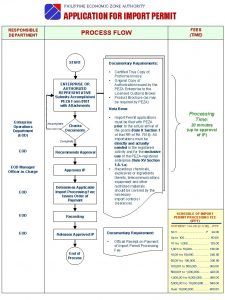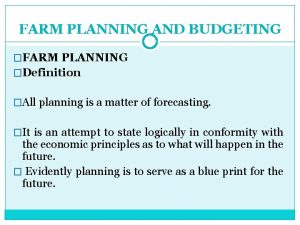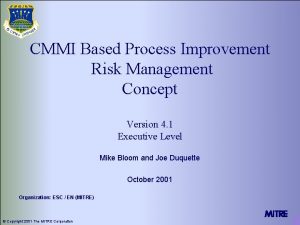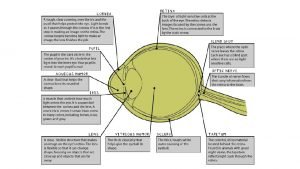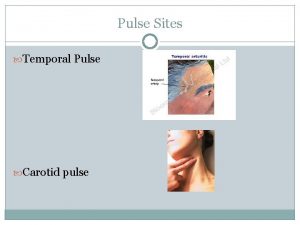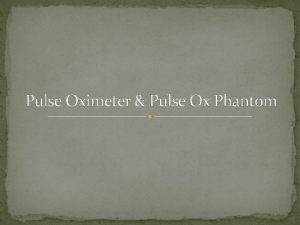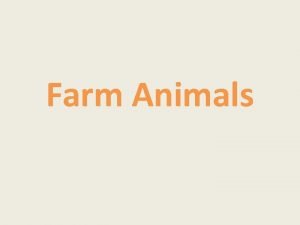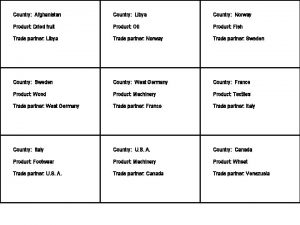Tough Times in Farm Country Taking the Pulse


































- Slides: 34

Tough Times in Farm Country: Taking the Pulse of the Agricultural Trade Climate The USMCA and the U. S. -Canada Trade Relationship Presented to American Agricultural Law Association October 23, 2019 Presenter Jessica B. Horwitz Bennett Jones LLP

Outline Timeline and Context USMCA: What’s New for Agriculture Prospects for Ratification 2

Renegotiation Context: “Trade Wars” 3

USMCA – Overview 4

5

NAFTA Renegotiations – USMCA (CUSMA) Trump campaign promise NAFTA trilateral trade agreement came into force on Jan. 1, 1994 Negotiations concluded September 30, 2018 Signed on November 30, 2018 What’s in a name? USMCA, CUSMA, MUSCA / T-MEC? Will not come into force until it is ratified Agreement signing tempered uncertainty, even if timing for implementation is uncertain 6

Canada-U. S. Agricultural and Agri-Food Trade Canada and Mexico are the United States’ top agricultural export markets, totaling a combined $40 billion in 2018 (including $15 billion in processed food & beverage products) 29% of all U. S. farm and food exports went to Canada and Mexico in 2018, supporting over 300, 000 American jobs. (Source: USDA) Source: Agriculture and Agri-Food Canada 7

8

9

USMCA: What’s New for Agriculture? 10

Dairy – TRQ Concessions (Canada) Canada granted dairy quota to U. S. worth approx. 3. 6% of market Slightly higher than what had been negotiated in CPTPP CANADA – Additional TRQs for Imports from U. S. Milk 50, 000 MT by year 6 Cream 10, 500 MT by year 6 Skim milk powder 7, 500 MT by year 6 Butter and cream powder 4, 500 MT by year 6 Cheese (Industrial) 12, 500 MT by year 6: • 6, 250 MT industrial bulk • 6, 250 MT any kind Other products of natural milk constituents 2, 760 MT by year 6 11

Dairy – TRQ Concessions (Canada) CANADA – Additional TRQs for Imports from U. S. Milk powders 690 MT by year 6 Concentrated or condensed milk 1, 380 MT by year 6 Yogurt and buttermilk 4, 135 MT by year 6 Powdered buttermilk 520 MT by year 6 Whey powder 4, 135 by year 6 (*TRQ eliminated after 10 years) Ice cream and mixes 690 MT by year 6 Other dairy 690 MT by year 6 Access for U. S. tonnage will increase by one per cent for an additional 13 years (to year 19) Except for whey powder, which increases to 10 years after which it is eliminated (and tariffs go to zero) 12

Dairy – Other Canadian Concessions Canada agreed to eliminate Classes 6 and 7 milk pricing Class 7 was created in March 2017 as part of Canadian Dairy Commission and provincial milk boards “National ingredient strategy” to make price of domestic milk ingredients more competitive with imports Export quotas and price controls (match U. S. market price) for milk protein concentrate, skim milk powder and infant formula Canada also agreed to resume its program to use skim milk domestically as animal feed 13

Dairy – TRQ Allocation Quota allocated on “dairy year” basis August 1 to July 31 TRQ will be allocated to “eligible participants” Active participants in the Canadian food or agriculture sector Previous importations not required Allocations are not first come first served Applications are considered by Global Affairs Canada (Import Trade Controls Policy Division) Designated application periods annually TRQ typically allocated to traditional historic import allocation holders Specific import permits required to claim allocation If over-access, GIP under EIPA must still be claimed (and duties apply) 14

Dairy – TRQ Concessions (USA) USA – Additional TRQs for Imports from Canada Fluid cream, sour cream, ice cream, milk beverages 10, 500 MT by year 6 Skim milk powder 7, 500 MT by year 6 Butter, cream powder 4, 500 MT by year 6 Cheese 12, 500 MT by year 6 Whole milk powder 690 MT by year 6 Dried yogurt, sour cream, whey and products of milk constituents 11, 030 MT by year 6 Concentrated milk 1, 380 MT by year 6 Other dairy 1, 900 MT by year 6 + additional 1% per year for 13 years 15

Canadian Concessions on Poultry, Eggs Canadian quota levels for poultry and eggs increased Chicken – 57, 000 MT by year 6, + additional 1% per year for 10 years Eggs – 10 million dozen eggs and eggequivalents by year 6 + additional 1% per year for 10 years Turkey, turkey products – WTO access guaranteed at no less than 3. 5% previous year’s total (translates to 1, 000 MT per year extra for U. S. and potentially more) 16

Sugar and Sugar Containing Products, Peanuts, Cotton, Margarine U. S. increased quota for Canadian sugar and sugar containing products Beet sugar, cane sugar, refined sucrose - 9, 600 MT Maple syrup, syrups, chocolate, confectionery etc. – 9, 600 MT TRQs on Canadian peanuts, peanut butter and cotton, and on U. S. margarine will be phased out over 5 years Margarine rule of origin for use in trade between U. S. and Canada will allow the use of non-originating palm oil 17

Other Market Access Points Notice and consultation required for future changes to tariff schedule involving dairy, poultry and egg, changes to milk pricing Meet after 5 years (and every 2 years thereafter) to discuss milk pricing. Increased transparency in import licensing procedures for TRQ administration public advance notice of TRQ administration changes, published utilization rates, written reasons for denying import licenses 18

Wine, Beer and Distilled Spirits Annex on wine, beer and distilled spirits Addresses BC, Ontario and Quebec regulations limiting foreign liquor National treatment for distribution, listing requirements Specific labelling rules to prevent labelling from being a non-tariff barrier Limits on differential in cost markups Chapter 3 - GI protections: “Bourbon Whiskey”, “Tennissee Whiskey”, “Canadian Whiskey”, “Tequila”, “Mezcal” Side letter on British Columbia wine 19

Equal Treatment of Grain Quality Grades Quality grades for grain will be granted mutual national treatment Parties shall accord “treatment no less favorable than it accords to like wheat of domestic origin with respect to the assignment of quality grades. ” Currently, Canada does not recognize U. S. grades, so U. S. wheat is priced as feed wheat in Canada No country of origin can be required on wheat quality certificates 20

Protection of Proprietary Formulas Annex 3 -D: Rule that Parties shall not request information about proprietary formulas for prepackaged foods unless a) Request is limited to only what is needed to achieve legitimate objective b) Confidential information is protected 21

Geographic Indications – Chapter 20 Recognition and accommodation of GIs agreed with other states Side letter between USA and Mexico lists 33 cheese names that will remain common as between USA and Mexico (which Canada must protect under the CETA) Processes for requesting new GI protections including transparency and notification requirements Detailed process for determining whether a food name is “common” 22

Sanitary and Phytosanitary Measures – Chapter 9 SPS Chapter Modernized Recognition that greater compatibility is required Call for greater transparency in development and implementation of SPS measures, equivalence assessments Rules for the conduct of audits, import checks New mechanisms for technical consultations 23

Agricultural Biotechnology and GMOs Section B of Chapter 3 specifically addresses biotechnology Parties “confirm the importance of encouraging agricultural innovation and facilitating trade in products of agricultural biotechnology” Transparency and access requirements for regulations and information on authorization for new products Authorization requests to be reviewed in timely manner Parties to communicate regarding new and existing authorizations to improve information exchange Working Group to be established 24

“agricultural biotechnology means technologies, including modern biotechnology, used for the deliberate manipulation of an organism to introduce, remove, or modify one or more heritable characteristics of a product for agriculture and aquaculture use and that are not technologies used in traditional breeding and selection” 25

What didn’t make it in? Proposal by southwestern U. S. produce growers to change trade remedy laws to address seasonal produce Non-tariff barriers to market access for U. S. fresh potatoes in Canada and Mexico Did not address the Canada and Mexico retaliatory countermeasures on food products (but that was subsequently resolved by negotiated settlement) 26

Other Notable Non-Agriculture Items 27

USMCA – Trade in Goods – General Provisions Chapter 4 addresses Rules of Origin De minimis (tolerance) threshold for tariff shift rules of origin increased to 10% from 7% Chapter 7 addresses trade facilitation Express (courier) shipments de minimis thresholds increased $150 for duties, $40 for tax (up from $20) Chapter 19 addresses Digital Trade Confirms no customs duties on digital products Parties must endeavor to accept trade administration documents submitted electronically Parties must adopt a legal framework that provides for the protection of personal information of digital trade users 28

USMCA – Other Notable Items Automotive Rules of Origin, exemption from s. 232 for autos ISDS and Procurement access no longer applicable for Canada Chapters still apply applies for Mexico, and Canada still has coverage with Mexico through CPTPP Intellectual Property – Longer terms for patent, copyrights Change in wording of National Security provision Numerous Side Letters Chapters on labour (23), the environment (24), trade promotion for small and medium enterprises (25), anti-corruption (27), good regulatory practices (28) 29

USMCA – National Security Tariffs s. 232 tariffs on steel and aluminum were not resolved in the USMCA but were discontinued for Mexico and Canada in May 2019 Side letter - 60 day notice period before future measures will apply to Canada or Mexico USCMA National Security clause less robust than NAFTA’s 30

USMCA – Non-Market Economy Clause Article 32. 10: 2. At least 3 months prior to commencing negotiations, a Party shall inform the other Parties of its intention to commence free trade agreement negotiations with a non-market country. 5. Entry by a Party into a free trade agreement with a non-market country will allow the other Parties to terminate this Agreement on six months’ notice and replace this Agreement with an agreement as between them (bilateral agreement). Highly unusual Not a restriction on sovereignty per se – but a signal from US that an FTA with China will cause issues 31

Prospects for Ratification? 32

USMCA Prospects for Ratification Fall 2019 is feasible, 2020 more likely Mexico has already ratified Canadian implementing legislation is ready to go, but Canada is waiting on the U. S. Both Liberals and Conservatives support passing the CUSMA U. S. ratification depends largely on US congressional politics Labour, Environment, IP, DSM chapters are contentious to Democrats in House Ways & Means Committee working group to address concerns Impeachment inquiry could distract 33

Thank you Jessica Horwitz Associate, International Trade & Investment 416. 777. 6517 horwitzj@bennettjones. com 34
 What is a collapsing pulse
What is a collapsing pulse Factors of 168
Factors of 168 Intra country vs inter country
Intra country vs inter country Host country and home country
Host country and home country Uses of farm structures and buildings
Uses of farm structures and buildings Pinchfield farm
Pinchfield farm What is peza 8105
What is peza 8105 Farm budgeting types
Farm budgeting types Signposts ela
Signposts ela Much to everyone's dislike the outspoken
Much to everyone's dislike the outspoken Notice and note tough questions
Notice and note tough questions Cmmi risk management
Cmmi risk management Tough questions anchor chart
Tough questions anchor chart Can you identify these cell structures
Can you identify these cell structures Tough outer covering of bone
Tough outer covering of bone How tough is the cornea
How tough is the cornea Reading signposts
Reading signposts Notice and note tough questions
Notice and note tough questions Pre molded nails shaped from a tough polymer
Pre molded nails shaped from a tough polymer Americanization is tough on macho
Americanization is tough on macho Tough background
Tough background I take it you already know of tough and bough
I take it you already know of tough and bough Bảng số nguyên tố
Bảng số nguyên tố Tia chieu sa te
Tia chieu sa te đặc điểm cơ thể của người tối cổ
đặc điểm cơ thể của người tối cổ Các châu lục và đại dương trên thế giới
Các châu lục và đại dương trên thế giới Tư thế worm breton
Tư thế worm breton Thế nào là hệ số cao nhất
Thế nào là hệ số cao nhất Hệ hô hấp
Hệ hô hấp ưu thế lai là gì
ưu thế lai là gì Tư thế ngồi viết
Tư thế ngồi viết Cái miệng bé xinh thế chỉ nói điều hay thôi
Cái miệng bé xinh thế chỉ nói điều hay thôi Mật thư anh em như thể tay chân
Mật thư anh em như thể tay chân Bổ thể
Bổ thể



